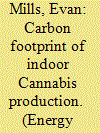|
|
|
Sort Order |
|
|
|
Items / Page
|
|
|
|
|
|
|
| Srl | Item |
| 1 |
ID:
112888


|
|
|
|
|
| Publication |
2012.
|
| Summary/Abstract |
The emergent industry of indoor Cannabis production - legal in some jurisdictions and illicit in others - utilizes highly energy intensive processes to control environmental conditions during cultivation. This article estimates the energy consumption for this practice in the United States at 1% of national electricity use, or $6 billion each year. One average kilogram of final product is associated with 4600 kg of carbon dioxide emissions to the atmosphere, or that of 3 million average U.S. cars when aggregated across all national production. The practice of indoor cultivation is driven by criminalization, pursuit of security, pest and disease management, and the desire for greater process control and yields. Energy analysts and policymakers have not previously addressed this use of energy. The unchecked growth of electricity demand in this sector confounds energy forecasts and obscures savings from energy efficiency programs and policies. While criminalization has contributed to the substantial energy intensity, legalization would not change the situation materially without ancillary efforts to manage energy use, provide consumer information via labeling, and other measures. Were product prices to fall as a result of legalization, indoor production using current practices could rapidly become non-viable.
|
|
|
|
|
|
|
|
|
|
|
|
|
|
|
|
| 2 |
ID:
190639


|
|
|
|
|
| Summary/Abstract |
Lack of finance is a key barrier to sustainable development. Formal aid and private investment are insufficient and vulnerable to inefficient government-to-government interactions and fail to reach some populations. Remittances from 280 million migrant workers to families at home represent enormous complementary monetary inflows to low- and middle-income countries, and, at $600 billion globally, are three-times greater than “top-down” Official Development Assistance. While commonly intended to alleviate poverty, remittances are rarely targeted towards sustainable development, and can even lead to environmental degradation. There is significant potential to align remittances with sustainability goals, assisted by emerging technologies and digital-finance platforms. Proactive “green remittances” can take the form of cash, goods, or services. They can be targeted to households, transportation, agriculture, entrepreneurial purposes, or community-level infrastructure projects. Applications include renewable energy, energy-efficiency, and a range of climate change resilience and adaptation activities. The article provides a unique synthesis of the existing literature, highlighting the lack of focus on proactively directing remittances toward sustainability, and identifies and assesses early targeting efforts in eight countries. Key policy challenges include awareness-building among remittance providers and recipients, identifying and pooling applicable locally-available goods and services, assuring quality, reducing transaction costs, and scale-up.
|
|
|
|
|
|
|
|
|
|
|
|
|
|
|
|
|
|
|
|
|